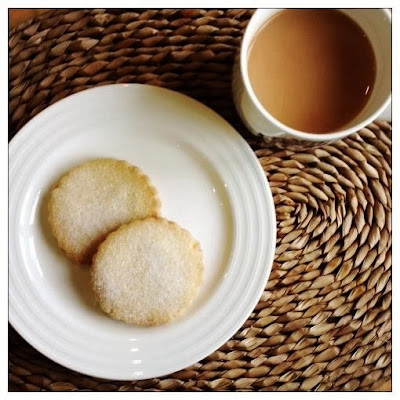The dough that I use to make these biscuits is my basic shortbread dough to which I add ground ginger and some finely chopped preserved stem ginger.
I roll out the dough to a thickness of about 1cm and then stamp out individual discs using a 6cm round-fluted cookie cutter. You can use cookie cutters in other shapes but, for these biscuits, I favour the restrained elegance of the fluted cutters.
Most types of shortbread biscuits are enhanced by a light sprinkling of caster sugar when they emerge just baked and hot from the oven - so that is what I do here. I love the way some of the tiny, sweet crystals always cling to my mouth after each bite of biscuit, forcing me to lick my lips and submit myself to another gentle kiss of sugar.
Shortbread contains very few ingredients and as such I really believe that you need to use the best that you can find. In particular, I urge you to use quality butter; the better the quality of the butter, the better the flavour of the finished biscuits.
One final piece of advice… These biscuits are wonderful with a nice cup of tea. The modern world can be a stressful and busy place, so it’s lovely making time to indulge in simple pleasures such as a cup of tea and a few homemade biscuits.
Ingredients:
300g plain flour
200g butter, softened
100g caster sugar plus a little extra to sprinkle over the shortbread
½ tsp ground ginger
3 balls of stem ginger from a jar of preserved ginger
Method:
1. Preheat the oven to 170C/Fan Oven 150C/Gas Mark 3. Line a baking tray with non-stick baking parchment and set aside.
2. Place the butter and caster sugar in a large
bowl and using a hand-held electric whisk, beat together until light and fluffy
and a pale colour. Finely chop the stem ginger into small dice and set aside.
3. Sieve the flour and ground ginger together,
add the diced stem ginger and work into the butter and sugar mixture with a
wooden spoon to form a dough. Knead briefly with your hands to bring together
into a bowl and place on a lightly floured work-surface.
4. Use a rolling pin to roll out the dough until
about 1cm thick and using a 6cm round fluted cookie cutter, stamp out discs of
the dough. Place on the lined baking sheets leaving space between each biscuit.
5. Bake in the preheated oven for approximately
20 minutes until the shortbread is a light golden colour. Remove from the oven
and lightly sprinkle with a couple of tablespoons of caster sugar. Leave to
cool. The shortbread keeps very well for several days in an air-tight tin.












